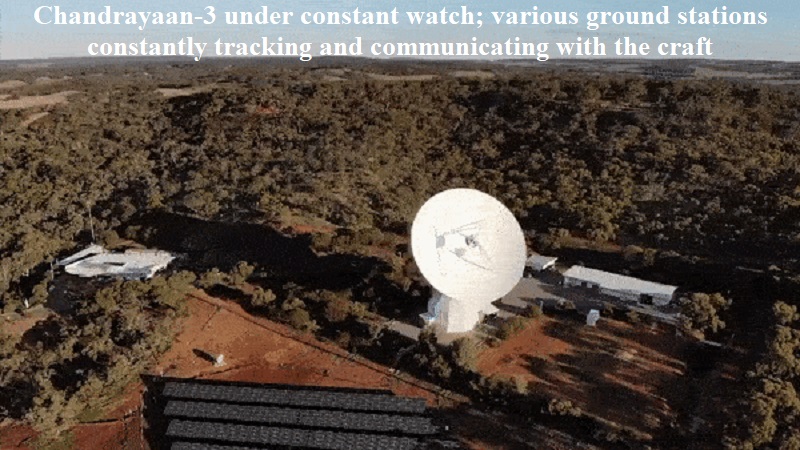
With the imminent lunar landing of India’s Chandrayaan-3 merely an hour away, a network of global ground stations is diligently engaged in monitoring, tracking, and maintaining communication with the spacecraft, ensuring its constant vigilance. The Mission Operations Complex (MOX), ISRO Telemetry, Tracking And Command Network (ISTRAC) in Bengaluru is at the core of operations, with support from various international space agencies, as India aims to achieve the distinction of becoming the fourth nation to successfully execute a lunar soft landing.
Assuming all goes according to plan and technical parameters remain within norms, the powered descent for the lunar soft landing will initiate at 5:45 pm IST. The outcome of this crucial phase will be determined by 6:04 pm IST, spanning just 19 minutes.
From a layperson’s perspective, the success of a rocket launch is often linked to satellite deployment into its designated orbit. However, this is merely the beginning of an ongoing process involving constant mission monitoring, wherein multiple aspects of the spacecraft’s health and performance are meticulously tracked. A properly functioning spacecraft must generate its own power, orient its antennae towards Earth, maintain functional systems and sensors, avoid space debris, shield itself from solar storms, and more. This continuous monitoring commences when the spacecraft is launched into orbit and extends throughout its operational life or eventual disposal through de-orbiting.
While launching rockets and spacecraft from Earth is one facet, the true achievement of a mission hinges on the establishment of an unbroken communication link between ground stations and the spacecraft. In essence, tracking and telemetry serve as the eyes and ears of any space agency. Through strategically positioned colossal antennae, it is feasible to locate, communicate, receive data, and issue commands to the craft.
During Chandrayaan-3’s 40-day journey to the moon, a sequence of maneuvers was executed to ensure its precise course. These maneuvers are based on commands issued from the ground stations operated by ISRO and its international collaborators.
ISRO Telemetry, Tracking and Command Network (ISTRAC) in Bengaluru is entrusted with the vital responsibility of offering tracking support for all satellite and launch vehicle missions undertaken by ISRO. The center’s objectives encompass mission operations for operational remote sensing and scientific satellites, Telemetry, Tracking, and Command (TTC) services from liftoff to satellite injection into orbit, and preliminary orbit estimation in space. ISTRAC collaborates with ISRO’s Indian Deep Space Network in Karnataka.
However, despite their size and capability, radar systems and communication antennae possess a specific range for tracking and communication. For rocket launches, global satellite constellations, and deep space missions (interplanetary or lunar), extensive antenna coverage across multiple locations is imperative. Establishing and maintaining such a network incurs substantial costs.
To address this challenge, ISTRAC has established ground stations across India in Bengaluru, Lucknow, Mauritius, Sriharikota, Port Blair, and Thiruvananthapuram. Additionally, ISTRAC operates overseas facilities in friendly foreign nations such as Brunei and Biak (Indonesia). However, for spacecraft like Chandrayaan-3 that traverse Earth’s orbit and venture further (the moon is approximately 384,000 km away), a global network of stations is essential for comprehensive tracking support.
In line with ISRO’s international collaborations, tracking stations under NASA, the European Space Agency (ESA), and the Swedish Space Corporation are tracking Chandrayaan-3 from diverse locations worldwide. These stations include South Point Satellite Station in Hawaii, Goldstone in California, Kourou in French Guiana, Madrid in Spain, Goonhilly in the UK, and Canberra in Australia. The synchronized tracking by Indian and foreign stations ensures continuous monitoring of Chandrayaan-3, optimizing its trajectory toward the moon.
Effective communication with a spacecraft necessitates line-of-sight alignment of ground antennae with the satellite in space. For instance, a Direct-to-Home (DTH) antenna captures TV broadcasts by orienting toward a specific broadcast satellite. However, with the moon positioned around 384,000 kilometers away and its visibility varying globally across different times and locations, maintaining constant tracking poses challenges. Collaborating with NASA and ESA, ISRO aims to ensure Chandrayaan-3’s near-continuous tracking by utilizing their stations in the US, Europe, Australia, and other regions whenever the moon becomes visible above their locations. This cooperative approach guarantees unbroken surveillance of the spacecraft’s journey.

Post Your Comments